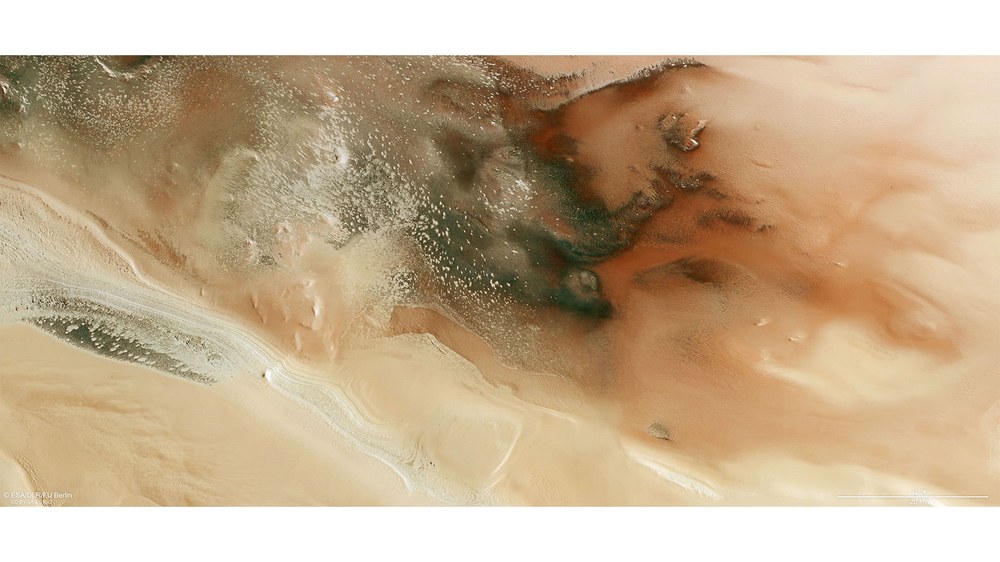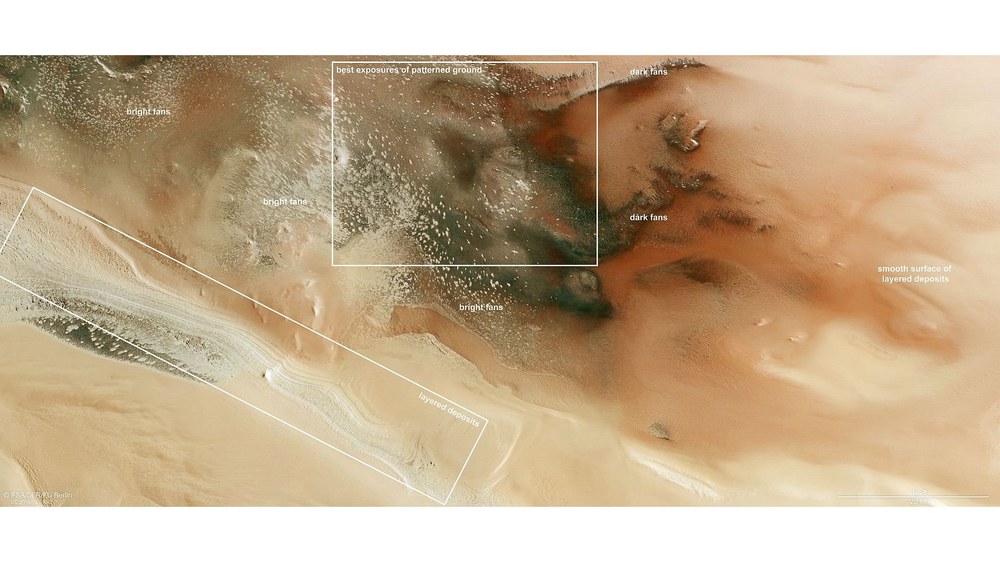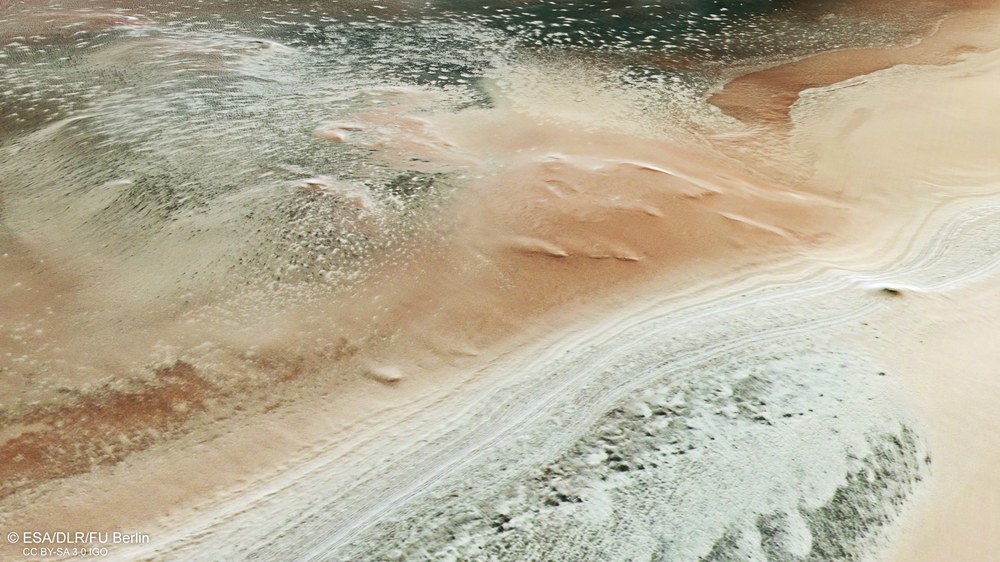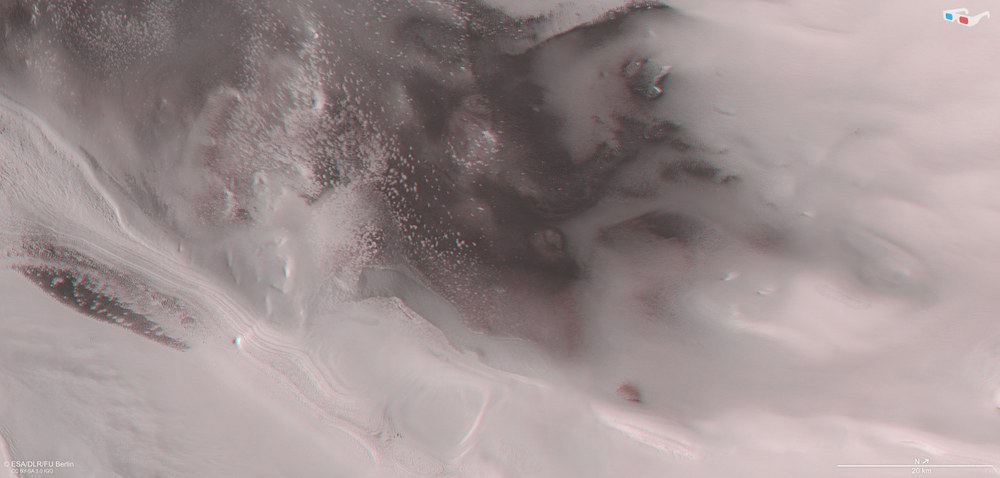Unusual landscapes at Mars' south pole



- New images from DLR’s Mars High Resolution Stereo Camera reveal the Australe Scopuli area of Mars’ south polar region.
- An astonishing variety of unusual landscapes can be found here.
- These terrains are the result of Martian seasonal changes and the processes associated with them.
- Focus: Space, planetary research, Mars
These images were captured by the High Resolution Stereo Camera (HRSC) onboard ESA's Mars Express spacecraft, developed and operated by the German Aerospace Center (Deutsches Zentrum für Luft- und Raumfahrt; DLR). They showcase the astonishing diversity of unusual landscape formations at Mars' south polar region. Light and dark fan-shaped deposits, white-spotted regions and polygonal patterns dominate the picture. The striking variety of shapes found in this area is a result of seasonal changes and the processes that accompany them.
These HRSC images were captured in early April 2024, during the spring in Mars' southern hemisphere. The region depicted, named 'Australe Scopuli', appears to have only recently emerged from its thick winter covering of frost.
While Mars' permanent polar ice caps are primarily composed of water ice, seasonal ice caps form on top of them each winter, made predominantly of solid carbon dioxide (CO2). As temperatures drop from autumn onwards, carbon dioxide in the Martian atmosphere condenses and trickles on to the surface as carbon dioxide ice, causing the polar ice caps to grow and reach as far as 55 degrees latitude by late winter. In spring, rising temperatures cause some of this ice to sublimate (transform from a solid directly to a gas), releasing large amounts of gas into the thin Martian atmosphere. These processes give rise to unusual surface features in the polar regions, which Mars researchers refer to as 'cryptic terrain'.
Fans, polygonal patterns and spotted floors – a cryptic terrain
The left side of image 1 is dominated by a vast accumulation of layered deposits, composed of a mixture of carbon dioxide ice and dust. In contrast, the right side shows the smooth surface of the polar layered deposits. At the centre of the image, the lower-lying areas of the region are visible, where darker tones prevail. On closer inspection, the surface reveals a network of polygons in varying sizes.

On Earth, such polygonal patterns are characteristic of periglacial regions in the Arctic and Antarctic, where they signal the presence of ice in the soil. The term 'periglacial' refers to landscapes and processes that occur in areas with permanent frost (permafrost) and derives from Latin, with peri meaning 'around' and glacies meaning 'ice'. Polygons are formed on Earth by soil movements triggered by repeated freezing and thawing cycles of ground ice over many years or even centuries. The resulting polygonal cracks then either fill with ice, debris or sand, or remain open. On Mars, the formation of these polygons is more likely to be caused by cyclical temperature fluctuations over longer periods of time, which either fill with sand or remain open. Such formations are also known as 'thermal contraction polygons'.
In many areas of the images, the Martian surface is speckled with white or dark dots, shown to be fan-shaped deposits when viewed more closely. The fans are always oriented in the direction of the prevailing winds, with lengths ranging from a few dozen metres to several hundred metres. The dark fans consist of fine-grained dark sands, and the lighter fans of carbon dioxide frost. Both types are however formed by the same process: the outgassing of carbon dioxide trapped in the ice sheet. This is driven by solar radiation and occurs in the form of gas eruptions, also known as CO2 jets.
The polar ice on Mars is made up of alternating layers of ice and dark dust or sand, as shown in the images. During early spring, sunlight penetrates the translucent CO2 ice layer, warming the dark material beneath it. This rapidly heats the ice to its sublimation point, creating pockets of pressurised gas. Eventually, the ice layer cracks, allowing the gas to escape in the form of CO2 jets. The escaping gas sweeps away some of the fine-grained dark sand as if in a fountain, transporting it to the surface where it is deposited in the form of dark fans.

Following this initial phase of activity, in which dark material is deposited on the ice surface, a second phase begins which sees the ice layer interact with the dark material deposited on it. Scientific theories suggest that the light-coloured fans may result from ice recondensation or from the dark fans themselves. As dark sand grains sink through the ice layer, they absorb sunlight and warm the carbon dioxide ice, causing it to sublimate and leave a hole. New carbon dioxide ice then recondenses on the sinking dark grains, forming bright fans in the place of the dark sand grains.
Another hypothesis suggests that the warmer dark sand or dust on Mars' surface affects the ice crystals, making it appear bright by greatly reducing the transparency of the ice and strongly increasing its reflectivity compared to the surrounding material. In general, these fans only form during the local spring until the transparent seasonal ice layer fully sublimates from the surface, at which point the fans are no longer distinguishable from the underlying surface.
Image processing
The images were taken by the High Resolution Stereo Camera (HRSC) on 2 April 2024 during Mars Express Orbit 25,569. The ground resolution is approximately 16 metres per pixel and the image is centred at about 265 degrees east and 85 degrees south. The colour image was created with data from the nadir channel – the field of view oriented perpendicular to the Martian surface – and the colour channels of the HRSC. The oblique perspective view was created from the digital terrain model (DTM), the nadir channel and the colour channels of the HRSC. The anaglyph image, which conveys a three-dimensional impression of the landscape when viewed with red/blue or red/green glasses, was derived from the nadir channel and a stereo channel. The colour-coded view is based on a DTM of the region, from which the topography of the landscape can be derived. The reference body for the HRSC DTM is the Mars equipotential surface, known as the areoid, which is an imaginary surface where gravitational forces are equal at every point.
HRSC is a camera experiment developed and operated by the German Aerospace Center (DLR). The systematic processing of camera data was carried out at the DLR Institute of Planetary Research in Berlin-Adlershof. The Planetary Research and Remote Sensing working group at the Free University of Berlin used the data to create the image products shown here.
Map server
To download the released raw images and Digital Terrain Models (DTM) of the region in GIS-compatible formats, follow this link to the map server
Related links
The HRSC experiment on Mars Express
The High Resolution Stereo (HRSC) was developed at the German Aerospace Center (DLR) and built in cooperation with industrial partners (EADS Astrium, Lewicki Microelectronic GmbH and Jena-Optronik GmbH). The science team, led by Principal Investigator (PI) Daniela Tirsch from the DLR Institute of Planetary Research, consists of 52 co-investigators from 34 institutions and 11 nations. The camera is operated by the DLR Institute of Planetary Research in Berlin-Adlershof.
